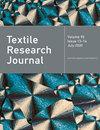A prediction method and its application for twist of slub yarn based on micro-element yarn
IF 1.9
4区 工程技术
Q2 MATERIALS SCIENCE, TEXTILES
引用次数: 0
Abstract
In the authors’ previous work, slub yarn was simulated by randomly determining the fiber position with the Monte Carlo method according to the draft principle of ring-spun slub yarn. In this paper, the total torque of each micro-element yarn was calculated by considering the contribution of fiber bending, twisting and stretching to the torque of yarn body. The micro-element yarn is a regular ring-spun yarn. The twist of each micro-element yarn can be calculated according to the equal torque between micro-element yarns and the conservation law of twists. The twist curve along the yarn axis also can be obtained. The simulation values of the slub twist and base twist can be obtained by calculating the average twist of the slub apparent segment and that of the base apparent segment, respectively. The twist angle and diameters of the slub and base apparent segments of the spun slub yarn were measured using scanning electron microscopy images, enabling determination of the measured values for both slub twist and base twist. The average error rate of the simulated value compared with the measured value for slub twist was 7.654%, while for base twist, it was 7.745%. The relationships between slub length, base length, slub multiple, design twist, and both slub twist and base twist were investigated. The correlation coefficient ( R) of the simulated and measured values was generally above 0.9, and the trend of the two was consistent. The work presented in this paper provides a basis for the development of virtual spinning technology.基于微元素纱线的竹节纱捻度预测方法及其应用
在作者之前的工作中,根据环锭纺纱线的牵伸原理,通过蒙特卡洛法随机确定纤维位置来模拟纱线。在本文中,考虑了纤维弯曲、加捻和拉伸对纱体扭矩的贡献,计算了每种微元素纱线的总扭矩。微元素纱是常规环锭纺纱。根据微元素纱线之间的扭矩相等和捻度守恒定律,可以计算出每根微元素纱线的捻度。同时还可以得到沿纱轴的捻度曲线。通过计算纱条表观段的平均捻度和纱基表观段的平均捻度,可分别获得纱条捻度和纱基捻度的模拟值。使用扫描电子显微镜图像测量了纺制的纱条和纱基表观段的捻度角和直径,从而确定了纱条捻度和纱基捻度的测量值。纱支捻度模拟值与测量值的平均误差率为 7.654%,纱基捻度的平均误差率为 7.745%。研究了纱线长度、基线长度、纱线倍数、设计捻度以及纱线捻度和基线捻度之间的关系。模拟值和测量值的相关系数(R)普遍高于 0.9,两者的趋势一致。本文介绍的工作为虚拟纺纱技术的发展提供了基础。
本文章由计算机程序翻译,如有差异,请以英文原文为准。
求助全文
约1分钟内获得全文
求助全文
来源期刊

Textile Research Journal
工程技术-材料科学:纺织
CiteScore
4.00
自引率
21.70%
发文量
309
审稿时长
1.5 months
期刊介绍:
The Textile Research Journal is the leading peer reviewed Journal for textile research. It is devoted to the dissemination of fundamental, theoretical and applied scientific knowledge in materials, chemistry, manufacture and system sciences related to fibers, fibrous assemblies and textiles. The Journal serves authors and subscribers worldwide, and it is selective in accepting contributions on the basis of merit, novelty and originality.
 求助内容:
求助内容: 应助结果提醒方式:
应助结果提醒方式:


